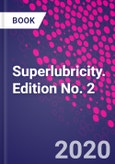Superlubricity - the state between sliding systems where friction is reduced to almost immeasurable amounts - holds great potential for improving both the economic and environmental credentials of moving mechanical systems. Research in this field has progressed tremendously in recent years, and there now exist several theoretical models, recognised techniques for computational simulations and interesting experimental evidence of superlubricity in practise.
Superlubricity, Second Edition, presents an extensively revised and updated overview of these important developments, providing a comprehensive guide to the physical chemistry underpinning molecular mechanisms of friction and lubrication, current theoretical models used to explore and assess superlubricity, examples of its achievement in experimental systems, and discussion of potential future applications.
Drawing on the extensive knowledge of its expert editors and global team of authors from across academia and industry, Superlubricity, Second Edition, is a great resource for all those with a need to understand, model or manipulate surface interactions for improved performance.
Please Note: This is an On Demand product, delivery may take up to 11 working days after payment has been received.
Table of Contents
I. IntroductionII. Theoretical aspects of superlubricity
III. Evidencing superlubricity at atomic-to-nanoscales (experiments and simulations)
IV. Superlubricty of lamellar solids (i.e., MeS2, graphite, coatings etc.) and other 2D materials
V. Superlubricity of carbon-based coatings (H-mediated superlubricity)
VI. Approaching superlubricity under liquid conditions and boundary lubrication
VII. Other systems where superlubricity has been observed or achieved
Authors
Ali Erdemir Texas A&M University, College Station, TX, United States. Ali Erdemir is a TEES Eminent Professor in the Department of Mechanical Engineering of Texas A&M University, College Station, Texas in the United States. His dedicated research on superlubricity, diamondlike carbon, superhard and slick nanocomposite coatings, as well as a range of nanolubricants and lubrication additives have been hailed as major breakthroughs in tribology field. In addition to receiving numerous awards and honors for his discoveries, Dr. Erdemir holds 26 US patents and has published more than 300 papers and 19 invited book/handbook chapters, and has edited 4 books. Jean-Michel Martin Ecole Centrale de Lyon, Departement de Sciences et Techniques, France. Jean-Michel Martin is Professor Emeritus with the Chemistry department at the Ecole Centrale de Lyon, France. Prof Martin has over 35 years' experience in fundamental and applied tribology, with specializations in surface chemistry, tribochemistry and chemical nano-analysis. He has published 14 patents and over 340 papers. Jianbin Luo Dean, Department of Mechanical Engineering and former Director, State Key Laboratory of Tribology, Tsinghua University, China. Jianbin Luo is Dean of the Department of Mechanical Engineering and former Director of the State Key Laboratory of Tribology at Tsinghua University, China. He is a member of numerous professional organisations, has been the Vice-President of the International Tribology Council since 2008, and has received multiple honours and awards for his work.Professor Luo has published 53 patents and over 250 papers in leading journals. In addition, he holds editorial positions at four journals and is a board member for an additional five.








